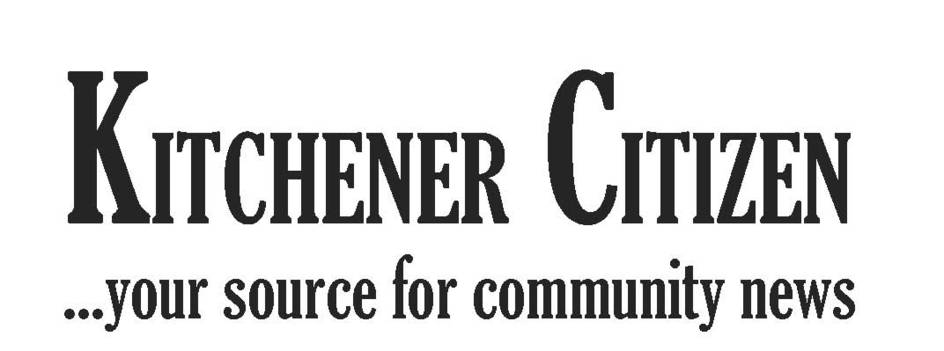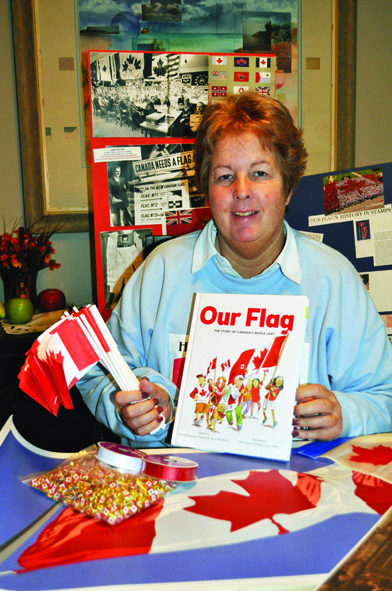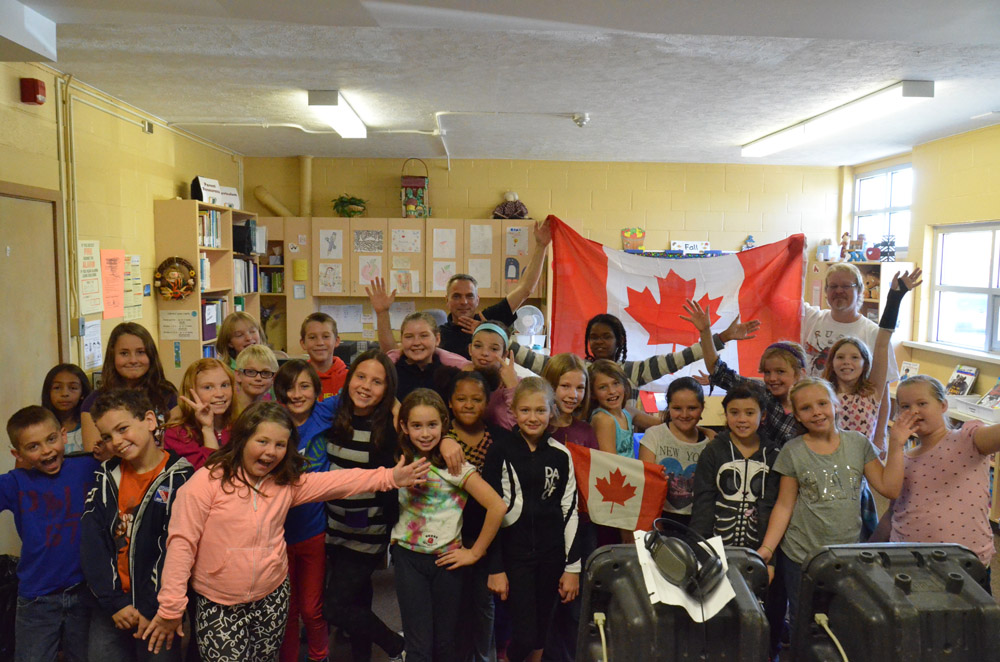

SMITHSON SCHOOL TEACHER COMPOSES SONG FEATURING CHILDREN’S CHOIR
Local group organizes projects, celebrations
to mark Canadian flag’s 50th year
Local group organizes projects, celebrations
to mark Canadian flag’s 50th year
For News Tips & Advertising call...
Kitchener East - 519-578-8228
Kitchener West - 519-394-0335
Diane Bonfonte
On October 22, a children's choir from Smithson Public School in Kitchener recorded the song Canadian Flag Waver in the school library. The commemorative song was written by composer Stephen Bergen (centre back), who is also a teacher at the school. It is one of several large projects the local group Flag Wavers of Waterloo Region is planning to mark the 50th anniversary of the Canadian Maple Leaf on February 15, 2015.
Photo by Rose Anstett
Photo by Rose Anstett
 by Carrie Debrone
by Carrie DebroneKitchener Citizen
November 6, 2014
If Diane Bonfonte has her way, in about three months everyone in Waterloo Region, and perhaps everyone across Canada, will be thinking about what the Maple Leaf flag means to them personally and to our country.
The Maple Leaf will celebrate its 50th anniversary on February 15, 2015.
Bonfonte and her friends Gloria Rudney and Muriel Soehner have launched an energetic campaign to mark the flag’s coming milestone and to showcase the Canadian symbol’s interesting history. The idea is expanding rapidly, and she is looking for support.
Bonfonte, who lives in Waterloo, came up with the idea after the three women hosted a display of photos and information about the Canadian flag at last year’s Waterloo Region Heritage Showcase - which was ironically held on February 15 – flag day.
“We were constantly amazed at how little people knew about its history and especially how long our flag has existed,” Bonfonte said.
“It sparked us to organize the group ‘Flag Wavers of Waterloo Region’ and to make plans to recognize this significant date in Canadian history. We just want people to be aware of the anniversary. So much in Canada is tied to our flag,” she said.
“Most people don’t know that the flag was originally designed with 13 points on the leaf. After wind tunnel tests to see how it looked when it was flying, the leaf was changed to have only 11 points.”
The three women are working on several flag projects, which they have so far funded themselves.
They commissioned Kitchener resident and songwriter, Stephen Bergen, to write a commemorative song about the flag, which he recorded two weeks ago at Small Dog Studio in Kitchener with the help of sound engineer Ian Graham.
The song titled, ‘Canadian Flag Waver!’ features Bergen singing with a 29-member children’s choir from Smithson Public School in Kitchener, where Bergen is a teacher. The recording of the children’s voices was completed in the school’s library on October 22 with the help of assistant choir director Sharon Scott.
Bergen has been composing music for about 30 years, creating, among others, songs for World Vision’s 30-hour Famine commercials, children’s folk music, choral music for the Kodaly Festival and music for television and radio.
“I really appreciated the opportunity to create this song. It was a fun project, I tapped into the love I have of this country. Kids need the opportunity to celebrate their country in a positive way and I just tried to make it a song that would instill a sense of gratitude and responsibility and make it a celebration of Canadian citizenship and identity,” Bergen said.
Bergen sings as well as plays all the instruments on the recording except the bass and the electric guitar.
CDs of the recording, which is now in the final stages of production, will be available in a few months.
Film footage taken during the recording of the children’s choir and at a planned Smithson School assembly later this month will become part of another one of the Flag Wavers projects – a half-hour video.
The video is being created with the help of Ben Wong, a former Rockway Mennonite High School student who is currently studying audio-visual sciences at Ryerson University in Toronto. Most of it was shot last August in Ottawa and includes an interview with the woman who sewed the prototype of the first Canadian Maple Leaf flag.
On a cold, snowy evening on November 6, 1964, Joan O’Malley, a 20-year-old Ottawa woman, sat at her sewing machine putting the finishing touches on three different prototype flag designs—one of which would become the Canadian Maple Leaf.
Her stitches were needed to finish the edges of the prototypes, which were each about 6-feet wide by 4-feet high, so they could be hoisted up a pole at Prime Minster Lester B. Pearson’s Harrington Lake residence. He wanted to compare how each one looked while flying in the wind.
It was late in the day when Prime Minister Pearson requested that Brockville MP John Matheson, who was chair of the committee formed to choose the design for the new flag, have prototypes made and brought to him by morning.
Matheson, called O’Malley’s father, Ken Donovan, who was then the Assistant Purchasing Director for the Canadian Department of Trade and Commerce’s Exhibition Commission and a personal friend. When Donovan was unable to find a seamstress, he called his daughter Joan.
“My dad quickly purchased the bunting (a thick cotton material used for the prototypes) and then had the designs silk screened onto it. We did six flags, two of each of the three final designs. I remember that it was a pretty cold and snowy night and I didn’t really want to go out, but I packed up my sewing machine and went.”
“I didn’t know the history we were making. I imagine that any Canadian would just love to have this memory in their life now,” O’Malley said in an interview from her home in Ottawa.
O’Malley started sewing about 7:30pm finishing just after midnight.
The committee in charge of choosing the design for the new flag received 3,600 submissions, including one from Group of Seven artist A.Y. Jackson. Most contained images of the maple leaf. They were narrowed to three choices, including one highly favoured by Pearson with blue sidebars and three joined long-stemmed maple leafs in the centre on a white background.
“When I was sewing them, I saw the red and white maple leaf and I knew that’s the one I would have picked,” she said of the design that eventually became the Canadian flag.
It is not known what happened to the prototypes she sewed. They have never been seen again.
“The last time I saw them they were wrapped in brown paper and delivered in the middle of the night to 24 Sussex Drive,” O’Malley said.
“I was asked not to say anything about sewing the flags. I kept it a secret for many years,” she said.
Although no one can say for sure, the request for secrecy was likely made because the development of the new flag became a contentious, hostile and divisive issue in Canada.
In 1965, Canada had been a nation for 96 years but still did not have a flag of its own. Many people wanted to keep the Royal Union Flag (British Union Jack), which was Canada’s official flag until 1946, while others favoured the Canadian Red Ensign that had been unofficially used since the 1890s. With the looming pressure of Canada hosting Expo ’67, Prime Minister Lester B. Pearson pitched his idea for a new flag in his speech to the Canadian Legion in Winnipeg in 1963.
O’Malley kept the secret about her part in the flag’s creation – not even telling her children, until ten years later when a reporter from the Toronto Star called to ask her about it.
“I called my Dad and he said, “Go ahead, tell your story.” In 1974, the newspaper printed a large story about her important role in Canadian history.
Along with her scrapbooks and news articles, O’Malley still has the sewing machine stored in her basement.
“I find it sad that the Canadian government doesn’t treasure our history like the Americans do theirs,” she said, adding that she believes her sewing machine should be displayed with other historical flag items, perhaps at the Parliament Buildings in Ottawa or at Queen’s University in Kingston where a drawing of one of the prototype flags is displayed.
Bonfonte has also approached the 2015 Oktoberfest organizing committee with a suggestion to include O’Malley in the 2015 Oktoberfest Parade with her sewing machine, and proposed that she be accompanied by 50 flag bearers -- perhaps some or all of them born on February 15, 1965.
O’Malley has requested that she be given the flag that is flown at Parliament Hill on November 6 (today), as a reminder of the day she sewed the first one.
“If I could have that flag, that would be the highlight of my life,” O’Malley said.
O’Malley’s story, one of many surrounding the creation of the Canadian flag, is presented in the Flag Waver’s video as a poignant interview with her in front of the warehouse where, 50 years ago, she helped make the prototype. It was the first time she had returned to the location and the first time she had been allowed to tell the story in her own words.
The video, which Bonfonte is currently negotiating to have narrated by a Waterloo Region celebrity, also includes interviews with Robert Labonte, current Flag Master at Parliament Hill, and Robert Harper, author of “The Brockville Connection-Canada’s Flag.” Harper became friends with former MP of Brockville John Matheson, chair of the federal committee that chose the Maple Leaf flag design, who passed away recently.
Because of Matheson’s work, Harper has initiated a campaign to have Brockville recognized as the birthplace of the Canadian flag.
The video also contains a look at unique National Archives documents, such as Prime Minister Pearson’s diary notes about meeting with Queen Elizabeth II to sign the document proclaiming the Maple Leaf as Canada’s national flag. The documents were sourced with the help of Glenn Wright a prominent Canadian history expert.
Seven women from St. Mark’s Lutheran Church in Kitchener have volunteered to hand-sew a banner-sized quilt featuring 12 panels with Canadian flags that represent Canada’s diverse landscape, seasons, heritage and cultures. The quilt will be displayed when the Flag Wavers speak at schools or visit community groups, and will become a part of its growing collection of flag memorabilia.
The song, video and quilt will all be unveiled at the project launch at Queen’s Park on February 18, 2015 (coinciding with Canadian Heritage Week February 14 – 18) that the group hopes will include Waterloo region supporters, local and national media, sponsors, local school students and MPPs, and government staff.
To help educate students about the history of our flag, two retired Waterloo Region District School Board teachers, Marg Dickson and Helen Koepke, have recently completed a series of activities and games around the theme of the Canadian flag to be used by teachers of students in JK to grade 8.
Flag Wavers has also developed a PowerPoint presentation that can be used by groups, schools or anyone wanting information about the flag’s history, and is developing a website that should be completed by mid-January 2015 to help communicate celebrations and projects.
“It’s amazing that they came up with a flag that can be embraced by all cultures. One that’s so acceptable to everyone. You come to realize how progressive the design is. The maple leaf is just something that seems to represent us all so well,” Bonfonte said.
To raise funds to help with the costs of producing the song CDs, quilt, PowerPoint presentation and video, the group plans to distribute 3,000 Canada pins with red and white ribbons attached. It is hoped that the pins will be requested by local businesses, schools, service clubs and the larger community in return for a donation.
If anyone is interested in having the pins, helping to create them or can help distribute them, has unique mementos of the flag or its history that they want to share, or would like to request the Flag Wavers of Waterloo Region as guest speakers, please contact Bonfonte at 519-578-1369 or email d_bonfonte@yahoo.ca
